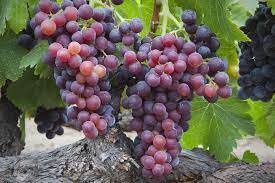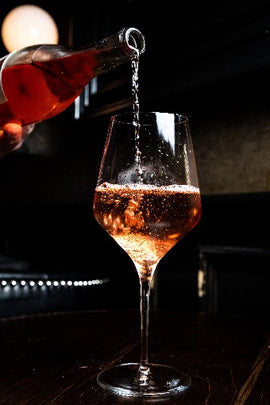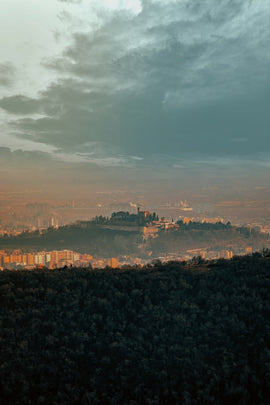What is the global wine grape? It could be Cabernet Sauvignon - currently the most planted. (It is definitely not Airen, the previous title-holder, a white varietal grown exclusively in Spain.) If we’re looking for something that will grow pretty much anywhere, we’ll take Chardonnay, cultivated in more countries than any other. In terms of prestige - and exchange value - it’s probably Pinot Noir from Burgundy. But if we had to pick a grape that really ties the tasting room together, an oenophile Esperanto, we might go with Grenache.
It’s not the most obvious choice. Grenache predominates almost nowhere, even the places where it is predominantly grown (Spain and France together account for some 80ish %.) It isn’t one of the 6 noble varietals, and though it was the world’s most planted red wine grape for a brief moment at the turn of the last century. It has since become more scarce, uprooted on account of EU vine pull directives. But Grenache is a grape so ancient its origins are still shrouded in argument (some claim it comes from Spain; others, Sardinia -where it is called Cannonau). It conjugates to an entire alphabet of alternate names, from Abundante to Vernatxa (including the essential white iteration Grenache Blanc), and it is the primary source material for most the world’s red blends. Any Rhone or Rhone-style blend, including Châteauneuf du Pape, is likely mostly Grenache, as are the prized reds of Priorat in Spain. It is frequently used in rose and dessert wine, and cultivated in some capacity in California, Australia, South Africa and the Middle East (there’s reputedly even 12,000 acres under vine in China.)
What makes it so ubiquitous? Grenache is a sturdy late-ripening grape that does well in hot and dry environments; the long growing season produces a high alcohol, fruit forward wine – lush, smooth and light on tannins – ideal for adding flavor and character to frequent blending partners like Syrah and Mourvedre. It is also quite terroir sensitive, so while red berry fruit like strawberries, raspberries (some even liken it to a fruit roll-up) are a relatively consistent hallmark, Grenache might also feature notes of pepper, leather, cinnamon, licorice, citrus fruit, oregano, flowers and earth, depending on age and point of origin.
In other words: if you think you don’t like Grenache, you probably just haven’t tasted the right one yet. So this quarter, we are excited to share three of our favorites from three different continents. From Australia’s Barossa Valley, the Cirillo Estate “Vincent” cuvee is culled from two vineyard sites hosting the world’s oldest Grenache vines, dating back to 1848. From southern Rhone in France, we have Domaine Gramenon, a relatively new label from a winemaking family committed to organic and biodynamic production in perhaps Grenache’s most distinguished region. And in California, Casa Dumetz’s Sonja Magdevski spent years exploring almost every last Grenache vine in Santa Barbara County to locate the right grapes for her extremely small production Clementine Carter label. As she says, “Farming Grenache is all about nuance. I have made a lot of Grenache in my 15+ years making wine and I joke that I don’t really know what Grenache tastes like.” We’re not sure either, but we look forward to many more years of trying to find out.
Cheers!
The PlumpJack Wine Buying Team
|
Location: Barossa Valley, Australia |
About the Winery: The Cirillo family moved to the small district of Light Pass in 1970. Vincent Cirillo became the custodian of some exceptional vineyards that were planted in 1848; today it is noted to constitute the oldest surviving and producing Grenache and Semillon parcels in the world. Their prized fruit went to well‐known producers; Rockford, Peter Lehmann, St. Hallet and Torbreck. Marco Cirillo, the youngest of four children, had always helped the family cultivate and preserve their precious Grenache, Semillon and Shiraz vineyards. It was during the late 1990’s when Marco was studying winemaking through Charles Sturt University in Wagga Wagga, and actively working as a cellar hand where he honed his skills as an exceptional winemaker that he is today. The family farm and ancestor vineyards grow in around 8ft of pure golden sand, which is a common terroir of the Vine‐Vale area. Marco and Vincent remain the only two people who have ever pruned the 1848 Grenache vineyard in the past 40 years. The early ‘basket‐pruning’ style that was adopted by Vince in the 70’s has helped the vines support themselves and continue to produce incomparable fruit each year. Their meticulous craftsmanship is why this vineyard is a picture of health today. About The Winemaking: From two 100+ year old vineyards from the renowned Barossa Valley. Aged 12 months in 90 year old Foudre barrels. 100% Grenache 14 14% ABV. Total Acidity: 6.8gms/l Residual Sugar: 0.05 gms/l pH: 3.5 Tasting Notes: The Vincent offers inviting aromas of rich fruit and white pepper. The palate is generous with intense true varietal characteristics. It’s delicately rounded and generous. A superb Grenache that has a lingering finish. A wine that can be enjoyed now, or well into the future |
|
Winemaker: Vincent & Marco Cirillo |
|
|
Price per bottle: $40 / Price per case: $432 |
|
|
Suggested Food Pairings: Stew Collard Greens Burgers
|
|
|
Location: Southern Rhone, France |
About the Winemaker: Michèle Aubéry-Laurent and her husband Philippe, bottled their first vintage of Domaine Gramenon in 1990, in the far northern-eastern stretches of the southern Rhône, in the town of Montbrison-sur-Lez. In 1999, in an unexpected twist of fate, Phillippe was killed in a tragic accident. Michèle was suddenly left on her own with their three children, vineyards, and a winery to deal with. Crushed but undaunted, Michèle stepped to the forefront, boldly picking up where Philippe left off. Over the years, Michèle has discovered her own creative voice in her new vocation; in so doing she has catapulted Domaine Gramenon into cult wine status. Today, she works twenty-six hectares with her talented son, Maxime François (a rising star in his own right), farming both young and very old vines alike. They employ organic and biodynamic practices in the vineyards, with a strong non-interventionist stance in the cellars. About the Winemaking: Domaine Gramenon is the authentic embodiment of the philosophies that the Laurents espouse. They do not merely champion organic farming, but they incorporate the concept of sustainability into their daily lives by growing their own food and raising their own animals. Though Michèle and Maxime continue to test the confines of the appellation, the cellars are unsurprisingly old-fashioned. The Laurents use gravity-fed tanks and age their wines in oak demi-muids and foudres. That they take such gutsy risks as bottling old-vine fruit with so little sulfur, without fining or filtration, only demonstrates the lengths they will go to in order to highlight the freshness, purity, and intoxicating aromas of their small, rare production. Clay, Limestone varied with gravel, galets roulés, and/or sand soils 50-70 year old vines. 100% Grenache. Grapes are partially de-stemmed and macerated for 15 days in cement tank. The wine ages for 12 months in barrique and demi-muids. Tasting Notes: Three terroirs make up this cuvée you would be sage to decant, or hold up to ten years in a cool place. A sandy parcel brings lively floral aromatics and elegant fruit, clay contributes depth and fleshiness, and a third plot on rocky limestone makes its presence felt on the tightly wound, almost salty finish. A masterpiece of old-vine Grenache. |
|
Winemaker: Michèle Aubéry-Laurent & Maxime François Laurent |
|
|
Price per bottle: $46 / Price per case: $496.80 |
|
|
Suggested Food Pairing: Roast Chicken Vegetarian Pasta
|
|
|
Location: Santa Rita Hills, CA |
About the winemaker: “My undergraduate work is in Political Science from the University of Michigan and my graduate work is in Journalism from Michigan State University. I received a Fulbright Scholarship to The Republic of Macedonia in 1998-1999 to study ethnic issues. The pursuit was to better understand the paths toward peace. I do that now through wine. My wine education and training are primarily on the job, in the vineyard and the cellar, and through the viticulture and enology classes at Allan Hancock College in Santa Maria, Calif. I started making wine in the garage in 2004 and moved to commercial production in 2008. My mentors and inspirations in Santa Barbara County and beyond are too many to list here. You’d be reading names and places for days. Thankfully the list keeps growing each year. This is a wonderful area to make wine with extraordinary fruit. Come and visit, taste some wine, and I will tell you all about it.” - Sonja Magdevksi About the winemaking: Spear and Robert Rae vineyards are the two vineyards used to source this wine, both are farmed organically. Spear receives morning warmth on its east facing sandy slope protected from the fierce oceanic westward afternoon winds. The fruit is plump, juicy and strategic in focus. Robert Rae is perched high above Santa Rosa road overlooking the entire Sta. Rita Hills from its intimate sunlight receiving west-facing clay-loam vista. 50% whole cluster fermentation. Long, cool gentle fermentation. 30+ days on the skins. Pressed into neutral French oak barrels for aging. Tasting Notes: “Winemaker Sonja Magdevski hit her stride in this vintage, and this appellation blend gives a great window into the style. Fresh and fruity aromas of cranberry, wild strawberry and cherry juice are leveled by a wet stone streak on the nose. The palate is very carbonic in style, ranging from snappy red fruits to wet gravel to a light white-sage aromatic flavor” - Wine Enthusiast |
|
Winemaker: Sonja Magdevski |
|
|
Price per bottle: $38 / Price per case: $410.4 |
|
|
Suggested Food Pairing: BBQ Salmon Sour cherry scones |
|





